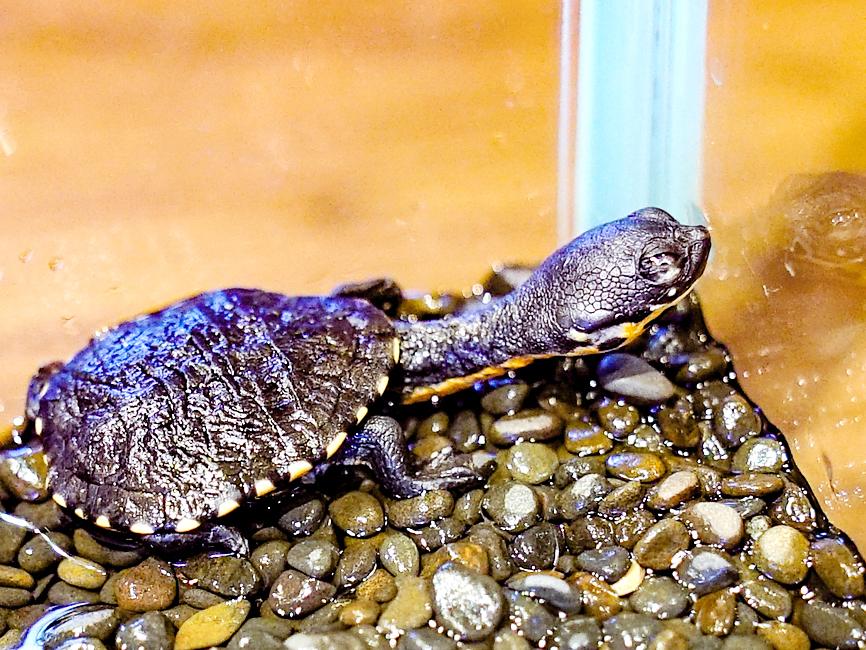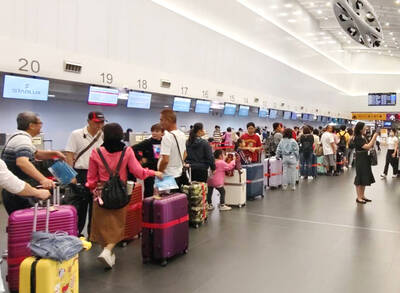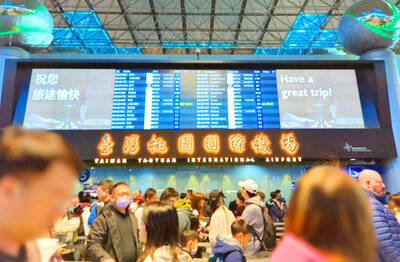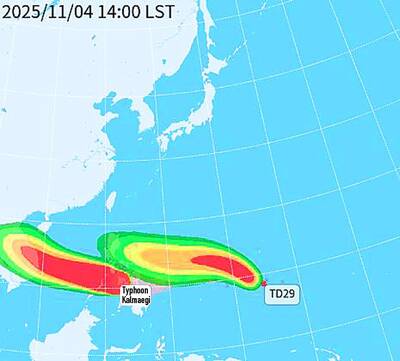Taipei Zoo has bred endangered Roti Island snake-necked turtles for the first time, it said on Wednesday.
The zoo said it bred two of the species, which is named for its long snake-like neck and the Indonesian island to which it is endemic.
“This is also a comparatively timid turtle. Even food frightens it when it first hatches,” the zoo said. “We finally got these two to eat by feeding them fruit flies and maggots.”

Photo courtesy of Taipei Zoo
The critically endangered Roti Island snake-necked turtle is native to Rote Island, and one subspecies can be found on nearby Timor, it said, adding that the species is mostly found in marshland, lakes and terraces.
They have yellow marks on their breastplates when they hatch that turn almost black within a few weeks, before gradually lightening into adulthood, it said.
Their shells grow to about 20cm in length when they mature, but their necks are too long to retract into their shells the way other turtles do, the zoo said, adding that they instead curl their necks around the sides of their shells while resting.
Due to hunting and the destruction of its natural habitat, the species is classified as critically endangered by the International Union for Conservation of Nature.
The zoo worked with the Turtle Island conservation center in Austria to import a Roti Island snake-necked turtle and attempt breeding, it said, adding that it produced its first fertilized eggs in April.
Eggs from the species typically have an incubation period of about 120 days, meaning that the eggs hatched this month, it said.
When hatched the turtles’ shells measured 2.5cm in length and weighed 3g, it added.
“These are aquatic turtles, so they spend most of their time in the water. When they are ready to lay eggs they come up on the shore, and then go back in the water afterward,” it said. “We have given this hatchling a shallow pool to move around in to be safe. We will gradually increase the depth of the water as it gets older.”
The Roti Island snake-necked turtle is a carnivorous turtle that normally feeds on small marine animals, it said.
“We racked our brains trying to think of what to feed them. We tried beef, chicken, worms and other things before we finally got them to eat fruit flies and maggots,” it said. “We will gradually diversify their diet as they grow.”

Three Taiwanese airlines have prohibited passengers from packing Bluetooth earbuds and their charger cases in checked luggage. EVA Air and Uni Air said that Bluetooth earbuds and charger cases are categorized as portable electronic devices, which should be switched off if they are placed in checked luggage based on international aviation safety regulations. They must not be in standby or sleep mode. However, as charging would continue when earbuds are placed in the charger cases, which would contravene international aviation regulations, their cases must be carried as hand luggage, they said. Tigerair Taiwan said that earbud charger cases are equipped

Foreign travelers entering Taiwan on a short layover via Taiwan Taoyuan International Airport are receiving NT$600 gift vouchers from yesterday, the Tourism Administration said, adding that it hopes the incentive would boost tourism consumption at the airport. The program, which allows travelers holding non-Taiwan passports who enter the country during a layover of up to 24 hours to claim a voucher, aims to promote attractions at the airport, the agency said in a statement on Friday. To participate, travelers must sign up on the campaign Web site, the agency said. They can then present their passport and boarding pass for their connecting international

WEATHER Typhoon forming: CWA A tropical depression is expected to form into a typhoon as early as today, the Central Weather Administration (CWA) said yesterday, adding that the storm’s path remains uncertain. Before the weekend, it would move toward the Philippines, the agency said. Some time around Monday next week, it might reach a turning point, either veering north toward waters east of Taiwan or continuing westward across the Philippines, the CWA said. Meanwhile, the eye of Typhoon Kalmaegi was 1,310km south-southeast of Oluanpi (鵝鑾鼻), Taiwan’s southernmost point, as of 2am yesterday, it said. The storm is forecast to move through central

Taiwan sweltered through its hottest October on record, the Central Weather Administration (CWA) said yesterday, the latest in a string of global temperature records. The main island endured its highest average temperature since 1950, CWA forecaster Liu Pei-teng said. Temperatures the world over have soared in recent years as human-induced climate change contributes to ever more erratic weather patterns. Taiwan’s average temperature was 27.381°C as of Thursday, Liu said. Liu said the average could slip 0.1°C by the end of yesterday, but it would still be higher than the previous record of 27.009°C in 2016. "The temperature only started lowering around Oct. 18 or 19